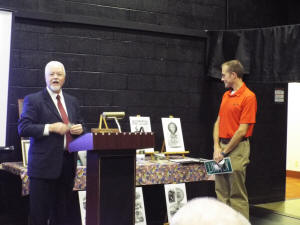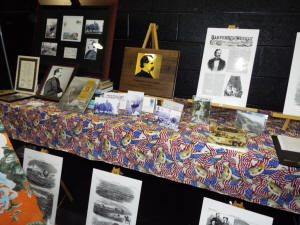|
 Lowe became acquainted with the folks at the LCG&HS
when searching for information for his family history. He noted that
the local genealogical society had provided him with a key piece of
information as a result of vigorous research within the local
histories. Lowe became acquainted with the folks at the LCG&HS
when searching for information for his family history. He noted that
the local genealogical society had provided him with a key piece of
information as a result of vigorous research within the local
histories.
Though the Lowe family has no specific background in Logan County,
the name and birthday Terry Lowe was seeking was still found in one
of the many reference books the LCG&HS have and use in researching
local genealogy as well as Abraham Lincoln history.
After the facts were acquired Lowe maintained some communication
with the LCG&HS offering to come to Lincoln and share information he
had gathered regarding his distant relative and that man’s
connection to Abraham Lincoln and the Civil War efforts.

Diane Farmer, who leads the Program and Event
Committee at the LCG&HS said that it had taken a while to get
everything coordinated, but she was happy that Lowe had been
patient, and had agreed to work the trip to Lincoln, Illinois from
Lincoln, Nebraska into his schedule.
Local Lincoln Mayor Seth Goodman was called on to offer up the
introduction of Lowe at the assembly. Afterward, Lowe presented
Goodman with a “Lincoln” street sign autographed by the Mayor of
Lincoln, Nebraska. Lowe said that the two towns share a number of
things in common. Both places have a love for President Abraham
Lincoln, both are namesake cities, and while Lincoln, Illinois has
the Lincoln College Lynx; Lincoln, Nebraska has the Lincoln
Community High School Links.

Lowe said he also understood that Goodman was a
balloonist. A few Years ago, there had been a replica of the
original Intrepid balloon built and inflated. At the celebration of
that inflation, lapel pins of the Intrepid were made available. Lowe
said he was pleased to gift one of those pins to the Illinois Mayor
and pilot.

Thaddeus S. C. Lowe often referred to himself as an inventor, but on
Saturday Terry Lowe said that his great-great-great uncle was as
much a chemist as he was an inventor. At a young age T.S.C. was
interested in chemistry and though his beloved balloon was the focus
of much of his work, he created other chemical-based inventions such
as artificial refrigeration. Terry Lowe explained that it was T.S.C.
that formed the Lowe Refrigerated Steamship Company. Within that
company, Lowe invented a method of refrigerating fresh foods for
transport. The artificial refrigeration was used in rail cars in the
United States and also in steam ships. But, the concept may have
been a little before its time, because it ultimately failed. Terry
Lowe explained that while the refrigeration units worked for
transporting midwest produce to the southwest and southwest meats
back east, consumers were not trusting in the safety of the
products. Up until then, shoppers primary options were preserved
foods, and fresh foods traveling long distances made them wary.
Another successful venture of T.S.C. Lowe was that of a railway
system to ascend what is today known as Mount Lowe in California.
Utilizing an urban transit system, Lowe designed trolley-like cars
that would ascend the mountain in stages. At the end of each stage
hotels were built, and in the end the mountain could be fully
ascended with stops and stays along the way.
A successful venture for Lowe was that of perfecting a means of
delivering Hydrogen generated gas for home lighting and heating.
In spite of T.S.C. intelligence, Terry Lowe also related that like
Abraham Lincoln, T.S.C. was self-educated. He completed only the
fourth grade in formal education, but studied constantly throughout
his life, and earned the title of Professor.
Terry Lowe said that while many of T.S.C.’s ventures were not
successful, he died a very wealthy man while living in California.
Through all of his accomplishments though, there were a couple of
things that he dreamed to do, but never accomplished.

First, he dreamed of crossing the Atlantic Ocean in a
balloon. It was a task he was convinced he could accomplish, but he
needed the support and backing of someone. He worked to get that
support from the city of New York, and his first balloon was named
the City of New York. He sought support from that town, but was met
with skepticism that he could actually make it all the way across
the Atlantic.
[to top of second column] |

Lowe changed his game plan and the name of the
balloon. Calling it ‘Enterprise,’ he traveled with his balloon to
Cincinnati, Ohio where he planned to inflate it and fly eastward to
Washington, D.C.
Lowe worked with the theory that the jet stream (then not widely
understood) would carry him eastward if he reached the right
altitude, something science in that day was not convinced of.
None-the less, he noted that when the wind was coming from the east
on the ground, he could ascend his balloon and the air would be
moving in the opposite direction, toward the east. On the right day,
he would ascend, and fly the 650 miles from Cincinnati to
Washington.
That day came in April of 1861, less than a week after the beginning
of the Civil War. Lowe inflated his balloon and true to his beliefs,
eventually headed eastward. However, the wind currents at elevation
were not flowing in a true eastward movement. Lowe, who didn’t know
where he was over land, only that he was going east, eventually
landed his balloon far off target, in Carolina. The airstream had
been moving in a southeasterly direction and when he came down, he
was behind the enemy lines, in Confederate territory.

Lowe was considered to be a spy for the union army and became the
first prisoner of war in the Civil War. However, he wasn’t held
long, as people in the northern territory vouched for him that he
was not a spy, and he was released along with his balloon.
However, the incident spurred a new ambition for Lowe. He realized
that from such a lofty height, he could indeed be a spy for the
Union Army, seeing for miles, he could report back to troops on the
ground, the movement of confederate forces, giving the Union days of
lead time to prepare for Confederate encounters.
Lowe took his balloon to Washington, D.C., where he inflated and
ascended over the city with a telegraph and a cable connected to the
ground 5,000 feet below. From his basket, he sent a telegraph to be
delivered to President Abraham Lincoln. The act got Lowe the
attention he needed from the President and he became the Chief
Aeronaut of Lincoln’s Civil War Balloon Corps. Lowe was commissioned
as a civilian, which was his second ambition not realized. He wanted
to be a member of the Army, an officer to be specific, but that
never happened. He was offered officer pay for his work, but never
got that official army recognition that he wanted.

Though it took time for Army leaders to warm up to
the idea of a balloon spy, it did eventually happen, and the team of
balloons consisting of the Intrepid, Constitution, Union, United
States, Washington, Eagle, and Excelsior, served Union Armies for
the better part of the Civil War.
Eventually, the Balloon Corp was taken from Lowe, and manned by
Union soldiers. From that point forward, there was a decline in the
success of the balloons as spying objects on the battlefront.
However, before that point in time, the balloons, and Lowe served
the Union Army very well, and offered a great deal of intel about
the confederate troops.
Terry Lowe recounted the details of the battle at Fair Oaks in
Maryland. That story can be found in its entirety at this link: “The
Drones of the Civil War - Meet the hot air balloonist who convinced
Lincoln to use aerial reconnaissance,” by Richard Holmes.

The first balloons Lowe used were powered by “city gas” produced in
each community through coal gasification. But to get the balloon
inflated it had to be taken to town and inflated then “walked” to a
clearing for lift-off.
Lowe engineered a hydrogen gas distilling method that was mobile.
Combining iron shavings, and sulfuric acid, he created a gas that
was too “hot” and acidic to be placed inside the silk envelope of
the balloon, but then added a cooling unit to the process which made
the gas less caustic and allowed him to become much more mobile with
his balloon.
Terry Lowe also played a 30 minute video of the re-enactment of an
Intrepid inflation using helium.

At the end of the meeting on Saturday, guests were
encouraged to view the collection of Abraham Lincoln and Thaddeus
Lowe documents and collectibles that Terry Lowe had brought with
him. Guests were also encouraged to enjoy refreshments in the lobby
furnished by the LCG&HS.
[Nila Smith] |